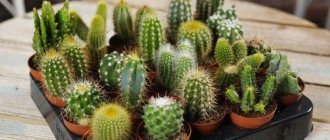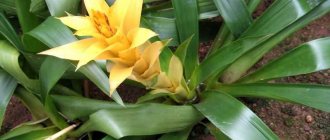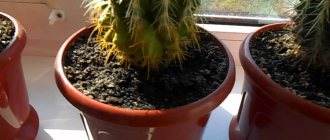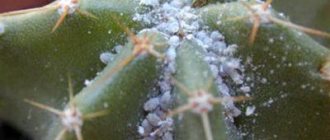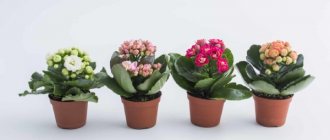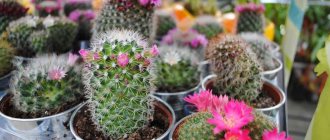How to care for a cactus mix
- 09.03.2017
I want to pay a little attention to indoor plants. Girls love to take care of flowers, indoor plants, various trees and other delights, thereby creating comfort in the house where they live. They try not only for themselves, but also for those around them, for their relatives and friends, for their other halves. Only it happens that all these efforts are in vain, and indoor plants do not grow, do not bloom, and constantly die, no matter how well they are cared for. Personally, I am very sensitive to flowers; if I buy a plant or someone gives it to me, I try to create such comfort that they can live well.
But this is not always possible to do, because either our climatic conditions do not have a beneficial effect on the plant, or, on the contrary, too much care, which begins to give the opposite reaction. Here you need a golden mean, or choosing a plant that will not bring you much trouble. What does a cactus need:
Although, if we look at the plants in a little more detail, we will see that, for example, spathiphyllium, or as it is also called “Women’s Happiness,” although it is considered an unpretentious plant, is still capricious from time to time. For example, in order for a plant to bloom constantly, it cannot be planted in a pot that is too large, otherwise it will fundamentally stop doing so. It will wait until the root system fills the entire space, and only then it will begin to bloom.
And then many people have the idea to buy cacti for home; they are also plants; they bloom very rarely, but they are not whimsical and do not require special care. But it seems to me that you are still mistaken, because any plant, even a cactus, needs its own care. You can buy a Mix cactus for home, but a legitimate question arises: how to care for a Mix cactus?
Description of the kit
Plant Mix is a combined set of plants that creates a picturesque composition. Flowers for the composition are selected in such a way that they are similar in appearance and require the same care.
To improve the decorative properties of the entire set, they are planted in identical pots. The diameter of the pots is small, no more than 10 cm. They are placed in a beautifully decorated box or tray.
The largest flower mix consists of 25 pots. This composition looks like a miniature garden. Similar compositions:
Fittonia Mix. Fittonia consists of 10 species and belongs to the Acanthaceae family. Each species has its own leaf color. It comes in green or red and lilac shades. There is even a variety with white leaves. To create a Fittonia Mix, 6 plant species are planted in one flower pot at once.- Dracaena palm mix. Often in flower shops you can find compositions called dracaena mix. This crop should not be confused with a palm tree. It has nothing to do with her. The composition includes some types of decorative dracaenas.
Each plant flower differs not only in appearance, but also brings benefits to humans. For example, cacti, ficus, succulents and dracaenas can absorb radiation from computer equipment. And ivy, dieffenbachia and spathiphyllum are capable of clearing the air of harmful substances and saturating it with oxygen.
Sometimes you can see the name Plantin Mix 8/25. The numbers mean: 25 is the diameter of the pot, 8 is the height of the flower.
How to care for mammillaria mix cactus?
We all know very well that cacti are the most unpretentious indoor plants. Only if the thought appeared in your head that you can buy it and put it on the window and safely forget about it. If you pay your attention to them, then soon they will delight you with their flowering, and let me tell you, it’s just a gorgeous sight.
How to care for Indian mix cactus?
They need bright, diffused light; the temperature in spring and summer is approximately 25 °C. But as for autumn, it’s worth lowering the temperature. Winter should bring cool temperatures to your cactus. But as for watering, in hot weather it is very necessary to cool the stem. But by winter you will need to reduce watering by half. The cactus, like other indoor plants, needs to be fed once a month when it blooms and when it grows. These are the basic rules for caring for a cactus. For example, how to care for a cactus mix with dried flowers, you can find more detailed information on our worldwide network. In the meantime, I wish you good luck and good choices. Let your indoor plant, whatever it may be, always delight you with its active growth and flowering.
Planting a cactus
This procedure does not present any difficulties. Echinocactus Gruzoni can reproduce both vegetatively (by children) and by seeds.
You will be interested to learn about such methods of propagation of cacti as vegetative and seed.
Children
Shoots, or “babies,” appear very rarely in this type of cactus. The stem begins to branch (produce babies) in the event of mechanical damage to the top or when the plant is on the verge of death.
When propagating by children, it is important to carefully separate the shoot from the mother stem. Rooting of the separated shoot into the prepared substrate, as a rule, occurs quickly.
Seeds
Much more often, seeds are used to propagate echinocactus. The best time for this is mid-spring. The seeds are soaked for several hours in warm water.
Immediately before planting, they are placed for ten minutes in a weak solution of potassium permanganate to avoid putrefactive mold, then sown in the prepared soil without deepening, sprinkled with a thin (1-2 mm) layer of soil on top.
Shoots appear in 10–30 days.
How to plant seeds
- Soak the seeds for several hours in warm water.
- Sow in prepared soil without deepening (sand can be used as soil).
- Cover with film and place in a bright place.
- Ventilate from time to time. Do not water, but spray with a weak solution of potassium permanganate to avoid putrefactive mold. Shoots will appear after 10–30 days.
- Drop the sprouts into separate pots. In the first year of life, this procedure will have to be performed several times.
How to properly care for cacti at home
Caring for a cactus is not particularly difficult. Experts note that these plants are among the most hardy and stress-resistant. Although it is still worth creating favorable conditions for their development.
Cacti are divided into two groups:
- Forest. These species grow in forest areas, so they need to create special conditions at home. Plants do not like bright sun, from which they should be shaded. Watering in the cold season is reduced to the bare minimum.
- Desert. This group of cacti is the complete opposite of the subspecies described above. Such plants die without sunlight, but at the same time, they also do not need abundant watering.
Types and varieties of Echinocactus
You can often find Gruzoni echinocacti on sale with neon pink, scarlet, bright yellow, and lilac spines. This is not the latest achievement of breeders, but the result of using a solution of ordinary food coloring instead of water for irrigation. If the buyer stops this practice, the shade of the thorns will quickly return to normal.
Most often found at home:
- Echinocactus Gruzoni Texas (texensis). The plant is spherical in shape, about 30 cm in diameter, slightly flattened on the sides. Height - no more than 15-20 cm. There are relatively few ribs - 15-25. Now, from a scientific point of view, this plant does not belong to echinocacti. According to recent changes in taxonomy, it is classified in the genus Homalocephalus. Even against the background of other “relatives” it stands out for its unpretentiousness.
- Echinocactus Gruzoni white-spined (albispinus). Selective hybrid. Sometimes thought to be a mutation that spontaneously arose in nurseries. It differs from the “parent” by the presence of snow-white spines. If the plant stands in direct sunlight for a long time, they gradually change their shade to sand or bronze, acquiring a kind of “tan.” At the same time, new spines grow white - a very interesting contrast is created.
- Echinocactus Gruzoni setispinus . It is distinguished by the presence of very thin, long (up to 7 cm) spines, more like hairs. As the plant matures, they lengthen further. An adult plant seems to be shrouded in a cobweb.
- Echinocactus Gruzoni spineless (subinermis) . It still has spines, but they are very short, no more than 1 cm long. There are no other differences from the “classic” version.
- Echinocactus Gruzoni crested (cristatus). Rarely found at home. It is distinguished by the presence of curved yellow-white spines of an interesting shape.
- Rare Echinocactus Gruzoni (monstruosus). The spines are very short. There is yellow-white pubescence on the top of the head.
- Echinocactus Gruzoni variegatus. Yellow and/or lime spots stand out effectively against the general dark green background of the stem.
How to care for a cactus so that it blooms
Often, when cacti are not properly cared for, they stop blooming. To prevent this from happening, you need to know how to care for the plant.
The first thing you should pay attention to is lighting. It varies slightly depending on the seasons.
Plants must receive light. Some species need more of it, some need less, but you can’t live without it. So, light-loving species must be placed on southern windows. If there are none, then any others will do, but it would be a good idea to take care of additional lighting so that the flower does not lack light.
Important! If the gardener notices a thinning of the crown, be sure to move the plant to a sunny place.
Summer care rules
In the summer, only forest varieties are hidden from the scorching rays of the sun, as they can burn. All others tolerate such conditions very well. In addition, during this period it is useful to take flowerpots with cacti to the balcony, loggia or courtyard. This procedure increases the plant’s resistance to various diseases and pests, and also increases the chances of excellent flowering. The only thing is to monitor drafts, or rather their absence.
Winter care rules
In winter, it is very important to maintain a minimum temperature in the room. Cacti do not like dry air, so they should be kept cool. If nothing can be done, then you can place the plant on the balcony, but at the same time make sure that the temperature does not drop below + 8°C.
Important! Cacti do not like constant rearrangement, so there is no need to move them regularly. This is especially true for the period before flowering.
How to grow?
It is necessary to grow a mix of cacti in loose and light soil . You can prepare it yourself by mixing the following ingredients in equal proportions:
- leaf soil;
- river sand;
- peat;
- charcoal powder.
As for the container, it should not be too deep, but at the same time wide. A round shaped pot is best. The cactus is not picky about the material from which the pot is made . It can be grown in a plastic or clay pot, as long as it is not metal.
Cactus mix - how to care for it and how to replant it
Some gardeners believe that the cactus mix is a special species. In reality, we are talking about the most popular Dutch varieties, which are planted in the same pot and sold together. Caring for cacti at home in this case is exactly the same as for all others. The same applies to transplantation.
It is best to start the last manipulation at the end of March. In general, mid to late spring is considered the ideal time. Young plants can be treated every year, and adults - once every couple of years. In order for the cactus to be pulled out of the old pot well, it should not be watered for about a week.
After assessing the condition of the roots and making sure that everything is fine with them, you can replant the plant. To do this, you will need a pot slightly larger than the previous one, drainage, which is placed in a small layer on the bottom of the pot, and also soil. Experienced gardeners recommend pouring a small layer of fine crushed stone after the drainage layer, expanded clay, charcoal on top of it, and only after that soil. When placing the cactus in a flowerpot, you should carefully ensure that the roots are not damaged.
Important! There is no need to water the plant immediately after transplanting. The procedure is carried out after 3-4 days.
In addition, it is advisable to take the plant away from the sun.
What is a cactus mix called?
The species diversity of cacti is great - only botanists and serious cactus growers understand all of them.
In order not to bother potential buyers with difficult-to-pronounce names, and also taking into account their desire to acquire several cacti of different species at once, in the Netherlands, where these plants are traditionally grown for sale, the concept of cactus mix was invented.
Thus, a cactus mix is not a specific type of cactus, but a mixture of them that can be grown in one greenhouse or just a pallet. Plants are selected according to shape, needle color, or mixed compositions are made. The main condition is the correct combination of cacti, which takes into account their growth, the same conditions of maintenance, and appearance.
There are a lot of combinations, as well as names, for example:
Indian mix or Indian line is the most common composition, which consists of cacti of different shapes, except for flat ones. Also common features of this type of mix are the small size of the plants and white spines.
Bol Mix (mix bol) - spherical cacti, except mammillaria. Gymnocalycium Mix - from grafted cacti. Mammillaria Mix - the set includes various types of mammillaria. Cactus Mix d8 - medium-sized cacti, mostly columnar, which can be single-shoot or branched; to complete the collection, one or two spherical cacti are usually added to it. Echinocactus Gruzoni Rainbow Mix - consist of cacti of the same name, often with brightly colored spines. Cactus Mix d14 - the collection includes cacti with many children, which gives them a cushion shape, or several cacti of the same type planted in one pot. Rondella - according to the name of the supplier, includes cacti of various shapes (round, hexagonal, elongated, branched, etc.). Showbox cactus - different cacti placed in a stylized box (a completely useless and even harmful thing, as it interferes with the lighting of the plants). Cactus ogen - a variety of cacti with eyes glued to them. Cactus dry flowers mix - with dried flowers glued on.
By the way! The designation d5 (d6, d8, d14) is not a name, as many people think, but the diameter of the pots.
Selection principle
You can create a mix yourself, selecting cacti according to your own preferences. It is important to consider the following indicators:
The size of the spines - they should not be too long so as not to damage neighboring plants; succulents from the same composition must be compatible and have the same care requirements; approximately the same size in height, so that some plants do not shade others; cacti should have the same growth rate.
By the way! Mixes can be made from the same type of cacti, but different varieties.
The most suitable types for creating unified compositions are:
- astrophytums;
- notocacti;
- Cereus;
- Gymnocalycium;
- ferocacti;
- Echinofossulocactus;
- Chamecereus Sylvester.
Important! You should not plant cacti together with other succulents in the same set, as they require different care, especially in winter.
How to properly feed a plant
Properly caring for a cactus means feeding it correctly, because without obtaining useful components, the flower will not delight you with lush blooms. It is important to note that organic matter is not used. The only exceptions are epiphytic plants, which are sometimes allowed to be fed with such fertilizers in small quantities. It is best to purchase formulations that include phosphorus and calcium - much-needed elements for the plant. Today there are plenty of similar fertilizers in stores, so choosing the right one won’t be difficult.
Attention! Fertilizers are not applied in the winter season, because it is often during this period that the plant blooms.
It is also necessary to pay attention to the fact that fertilizing is used from April to September. Fertilizers are used no more than twice a month. An excess of even useful substances often leads to the death of a cactus.
Features of Echinocactus
Echinocactus is part of the Cactaceae family. Under natural conditions, it can be found in the southwestern part of the United States and in the desert areas of Mexico. There are many species of this plant, but the most popular among gardeners is the Echinocactus Gruzoni, which is also the most common species in nature. This perennial is characterized by slow growth, and locals call it “hedgehog cactus.” The fact is that the needles and shape of this plant are very similar to this animal. This species of Echinocactus was named after the German cactus collector and inventor Hermann Gruzoni.
Under natural conditions, such a cactus can reach very large sizes. Moreover, the echinocactus Gruzoni in nature can be gigantic: it can grow up to about 100 centimeters in width, and up to 150 centimeters in height. This is a long-lived plant that can grow on average from 200 to 500 years. While the bush is young, it has a spherical shape, which over the years changes to a barrel-shaped one. That is why this plant is also called the “golden barrel”. Over the years, the appearance of such a cactus undergoes significant changes. When the bush is 3 or 4 years old, its small tubercles turn into sharp ribs, which are covered with sharp and strong spines. The upper part of the bush gradually grows, and at first it is covered with “fluff”, which is actually not hardened thorns.
The stem of the Echinocactus Gruzoni has the shape of a ball, and its surface is covered with vertically located sharp ribs, and there can be 35–45 of them. The shiny stem is green. Needles grow in bunches from areoles, which are located on the ribs of the plant. Each areole grows 1–4 central spines and approximately 10 radial spines. Their length can vary from 30 to 50 mm, with the radial needles being shorter than the central ones. The growing upper part is decorated with a spectacular “cap”, consisting of young spines that look like fluff. The needles can be colored in various shades from pale yellow to white. Please note that there are no Guzoni echinocacti with green, red or deep yellow needles. These cacti are grown specifically for sale using dyes. After some time they acquire their natural color. However, if harmful paints were used to grow such a bush, it may get sick and die.
In indoor conditions, such a plant can reach 0.4 m in diameter and from 0.4 to 0.6 m in height. However, a cactus will be able to reach this size only after several decades. Echinocactus blooms very impressively, but the first flowers appear on it only after it turns 20 years old. Flowering is observed in May–June. First, a bud on a long stalk forms in the upper part of the bush, and a yellow flower opens from it. There is pubescence on the outer surface of the funnel-shaped tube. The glossy petals are quite thin, closer to the edge their color becomes darker with a brownish tint. The diameter of the corolla reaches about 50 mm, and its length is up to 70 mm.
Echinocactus gruzoni / Cactus care
Methods for watering cacti at home
Many gardeners are accustomed to the fact that plants must receive sufficient water. This is true. However, cacti at home are not watered abundantly because they do not need it. While forest species can be irrigated with some regularity, desert species are watered extremely rarely. Clean water is used for the manipulation. You can take rain or settled water. Many people irrigate with water from under a filter.
Particular attention is paid to watering by month. The fact is that an incorrectly performed procedure can lead to the fact that the gardener will not be able to see his favorite plant blooming, because it will refuse to throw away even the buds.
Therefore, in winter, which for plants occurs at the end of November - beginning of March, adult specimens are watered once every 4 weeks, and young ones - once every 20 days. At the same time, under no circumstances should you flood the cactus; it does not need excess moisture. When buds appear on the flower, the frequency of watering can be increased slightly, but this does not apply to cereus species; at this stage they are only sprayed with warm water.
Important! If you fill a cactus at the budding stage, you will see “babies” instead of flowers.
It is better to water the presented plants rarely or not to water them at all for a month than to overwater them and cause the flower to rot.
With the arrival of spring, all living things begin to “wake up”. The same applies to cacti. The temperature outside the window gradually increases, and with it the amount of watering needs to be increased. Gardeners advise carrying out the manipulation 2 times a month in March, increasing watering to three times a month in April, and carrying out the procedure every 5-7 days in May. Spray the cactus no more than once every 15-20 days. Such care at home will enable the plant to prepare for the hot summer. At this moment, watering is carried out based on the condition of the substrate. If the flower pot is located outside, where the daily temperature does not drop below +33..+35 °C, then you can safely carry out the manipulation every other day. On rainy days, of course, water the cactus less often.
The conditions for keeping cacti in the autumn must be special, because, starting from this moment, the flower can already be prepared for the upcoming dormant period. At this moment, you need to take care of lowering the temperature in the room and reducing the watering schedule. For example, if in September it is still possible to carry out the procedure every 7-10 days, then with the onset of October, watering is carried out less frequently - once every 14-16 days. As for watering in winter, this has already been said.
Description and composition of the set
Plant Mix is a flower (the photo in the article shows the variety of possible flower arrangements) created from several similar types of herbaceous ornamental mini-plants. When choosing varieties for selection, preference is given to species that are characterized by slow growth and ease of care. For example, cacti, ficus, fittonia.
If the mix is planted in one container, then the best choice would be varieties of the same type, differing in external characteristics, for example, color, leaf shape or pattern on the leaf blade.
From succulents
This group of flowers includes a variety of plants that are similar to each other in some characteristics. This allows florists to fully realize their potential and create the most unique, original, incredibly beautiful compositions.
Among the succulents, the most widely used flowers are:
- echeveria;
- aloe;
- sedums;
- Crassula;
- pachiveria;
- Haworthia.
These types of plants, correctly planted in one flower pot, will become a wonderful decoration for any interior. The best part about creating such mixes is that succulents are easy to care for.
Favorable conditions for them are:
- sun and diffused light;
- optimal room temperature (20-25° C);
- low-nutrient substrate;
- fairly rare soil moisture;
- appropriate air humidity.
Certain types of mini-succulents, including cacti, require a period of rest. During the cold period of the year, the temperature in the room where they are grown is lowered to 10-12 ° C, and soil watering is replaced by spraying the above-ground part of green spaces.
To cultivate succulent mixes, you can use not only boxes, pallets or crates, but also decorative glass containers (for example, sinks, small aquariums, jars), you can also plant plants in driftwood, which will look very unusual and exotic.
From decorative deciduous
Plant Mix, created from miniature decorative foliage flowers, will be no less beautiful and attractive for creating a small green indoor garden. In the photo in the article you can see how original and beautiful the interior looks using a similar composition with beautiful foliage.
The following are often used as decorative foliage plants for the mix:
- dracaenas;
- Dieffenbachia;
- ficus;
- ivies.
Deciduous plants are planted in separate small pots and then placed on a common pallet or box. To ensure that the flowers grow and develop evenly, individual pots or a common tray with plants are constantly rotated.
What you need to know about cactus pests and diseases
Caring for a cactus is not particularly difficult, so you can’t run into problems with it. If you keep the flower in the conditions that were mentioned, then nothing bad will happen.
Typically, a gardener is faced with root rot, which occurs due to excess moisture. At the initial stage, the issue can be resolved. To do this, you need to remove the plant from the pot, carefully shake off the soil, remove all rotten roots, and treat the remaining ones with some kind of antiseptic. After this, the plant is transplanted into a new pot with new soil. Watering is carried out only when it is noticed that the cactus has begun to grow.
Important! In order to prevent diseases from making themselves felt, you should properly care for cacti at home, listening to wise advice.
As for pests, they rarely make themselves known. Typically, the plant may have scale insects, aphids, spider mites or mealybugs. They should be controlled with insecticides. Although experts note that such “guests” live only in apartments where the air is too dry or, on the contrary, humid.
Diseases and pests
When growing mix cacti, the following problems are possible:
- Plants form twisted stems and small thorns - the result of improper wintering.
- The cacti are covered with a crust of lime and are rotting due to improper watering.
- The redness of cacti is the result of being in bright sunlight, without shading from direct rays of the sun. The plant gets burned, which leads to its redness.
- Shrinking of plants . Occurs due to a sharp and severe cold snap.
- Brown spotting is the result of too intense lighting, high humidity of the surrounding air and soil, and excess fertilizer.
- Stopping the growth of buds and their falling off occurs due to the use of cold water during irrigation.
- Etiolation is the result of insufficient lighting of the plant. The cactus becomes colorless and its stem becomes elongated.
Among the pests that affect cactus mix are aphids and red mites. If they are detected, it is necessary to treat with insecticides:
- Spark.
- Tanrek.
- Aktara.
Cacti mix is a whole set of Dutch cacti that differ in size and appearance. It is not difficult to care for them if you create proper conditions in your apartment, regularly fertilize and monitor the soil moisture.
Cactus mix: types and features of care
Cactus mix is a composition of small cactus plants grown in one pallet. Many lovers of these plants are attracted to this form of cultivation. However, not everyone knows how to choose the right cacti for a set, how to care for such plants, and how to propagate these representatives of the flora. Before you get such a green decoration for your home, you need to familiarize yourself with the theory of care, as well as purchase the necessary equipment. Information on all of the above issues is presented in this article.
Types of echinocacti with photos and names
The most popular in indoor floriculture is the Echinocactus Gruzoni. The remaining species, of which there are not so many, differ from Gruzoni in the color of flowers and needles, as well as in the number of ribs.
Echinocactus Gruzoni
Its spherical stem is decorated with pale yellow spines. Over time, the stem becomes more elongated and resembles a barrel in shape. This type differs from the others in the number of ribs - there are at least 35 of them.
Echinocactus planosumata
This species comes from Mexico, and in nature it can reach about 200 cm in height and about 150 cm in width. There are no more than 25 ribs on the stem. Gray spines with transversely arranged dark-colored streaks grow from the areoles in bunches; their length can vary from 35 to 45 mm. During flowering, the bush is decorated with yellow tubular flowers. Compared to the Echinocactus Gruzoni, this species blooms somewhat more often in indoor conditions.
Echinocactus Parry
This cactus is small in size. In nature, the bush can reach a height of about 0.3 m. The number of ribs varies from 13 to 15 pieces. Over time, the shape of the stem changes from spherical to cylindrical. The plant is colored bluish-gray. The needles of this species are very long and can reach a length of about 100 mm. As they age, the color of the spines changes from brownish-pink to white. Indoor echinocactus Parry reacts extremely negatively to excess moisture, as it can cause rot on the root system.
Echinocactus horizontal
This species was called horizontal due to the shape of its stem. As it grows, it does not stretch upward, like in other species, but becomes flattened. It has 10–13 ribs, and they are twisted in a spiral. Each areole grows 5 or 6 curved spines. The needles are colored red, which changes over time and becomes amber. The color of the flowers is reddish-lilac. This species is also sometimes called “red echinocactus”.
Echinocactus broad-spined
The bush is decorated with numerous gray wide needles. In nature, the height of the bush can reach 150–200 cm. If you care for the plant correctly, it will delight you with funnel-shaped yellow flowers.
Echinocactus multicapita
In indoor conditions, such a cactus can reach a height of about 0.7 m. Its needles are colored, and they can be brownish-red, yellow or pink. There are from 15 to 20 ribs on the stem.
When purchasing such a plant, remember that there are species of Echinocactus with colored needles, but this does not apply to the Echinocactus Gruzoni. In order not to buy a cactus with spines painted with paint, you must check the number of ribs and needles in the areoles. Based on these characteristics, you can determine the type of such plant.
Echinocactus
Peculiarities
Like any indoor plant, the cactus mix has its own unique characteristics. There are several main points.
- To grow a “set” of plants, you need to select varieties of cacti that get along well with each other. Often Dutch varieties are combined in the mix.
- The rule for maintaining such a mini-greenhouse is also the same size of all its components. Otherwise, taller cacti will shade others, throwing off the balance.
- Each cactus should be placed in a separate container (mostly small pots are used for this). It is advisable that they be made of plastic, which is mainly suitable for young cacti, or clay. The round shape of the vessels is preferable, since it is thanks to it that air circulation in the soil improves. All containers with plants are placed close to each other in several rows, thereby creating a single composition.
- Combining cactus varieties with other types of succulents in the same mix is not advisable. Despite the same size of plants, their climate and care needs can vary greatly, which subsequently complicates the process of growth and development of these representatives of the flora.
- Unlike a simple cactus, mixes look very unusual and creative, since the components harmoniously complement each other and form different compositions. This green decor fits well into some interior concepts, for example, eco-style.
- You can expect plants to bloom only with proper care. For the most part, cacti bloom infrequently and only under ideal conditions.
- The most suitable place to place a small greenhouse would be a window sill, since it receives a lot of the light that cacti need. However, you should ensure that plants are not located too close to heating radiators.
Pests, diseases, possible problems and their solutions
The infestation of plants by pests and the development of possible diseases depends on the types of flowers collected in one green garden. For example, very often decorative deciduous varieties are attacked by aphids, but if a large number of dwarf palm trees are collected in the composition, then the pest will not like it.
The most common pests and diseases of Plant Mixes:
- Aphid. Small, inconspicuous insects that attack the surface of plants, usually from the inside of the leaves. If only a few leaves are affected by aphids, they are removed, but if the pests spread to other parts, the plant is completely destroyed. A solution of laundry soap will help get rid of aphids (20-30 g of soap dissolves in 1 liter of water). The root part of the flower is sprayed with the prepared solution.
- Shield. Small insects with wings that suck nutritious juices from plants. Insecticides are used to neutralize them.
- Spider mite. The pest envelops the stem of the plant with a small cobweb, after which the leaves dry out and curl. To eliminate the pest, diseased areas of the plant should be treated with an alcohol solution and then rinsed with water.
- Black rot. The disease develops due to excessive waterlogging of the soil. It is manifested by the appearance of black spots on leaf blades, stems, and roots. To eliminate the problem, plants are treated with a fungicidal solution, and the frequency of watering is reduced. In addition, the flowers are transplanted into other pots with a complete replacement of the substrate.
Plant Mix sets usually consist of plants that have dense, smooth leaves. These are the ones that have a high degree of resistance to various diseases and pests.
For greater effectiveness, it is recommended to treat flowers in several stages, changing fungicidal preparations. Among the most effective are Aktara and Actellik. After treating the plants, the grower must first regularly inspect the plant for damage in order to prevent relapse.
At the very beginning, Plant Mixes were created for the purpose of conveniently placing flowers on small window sills or on shelves; later, such flowers began to be combined into one composition, which allows you to perfectly diversify both home and office interiors.
In the photos presented in the article you can see how great different types and varieties of plants are combined in one set. In addition to beautiful landscaping, the benefit of Plant Mixes is to purify the air from dust and electromagnetic radiation, which is why they are often located in offices near computer equipment.
Varieties
The group of cacti that make up the composition of a mini-greenhouse may include various types of mini-succulents, each of which, in addition to general characteristics, has individual characteristics. The most popular are several types.
- Gymnocalycium Mikhanovich is a cactus with an unusually shaped colored stem with several sharp edges. The color of this small plant can be rich green, brown or even whitish. Such a plant is grafted onto a green cactus rootstock.
- Espostoa is an unusual species of cactus plant. Its main feature is soft long white hairs instead of the usual prickly needles. Such an instance will successfully dilute the overall composition.
- Red ferocactus is another type of cactus that is suitable for a mix and attracts attention. The peculiarity of the plant is its rather long and bright needles. In this case, the size of the stem can be no more than ten centimeters. It is colored red, which is quite unusual for this family of plants. The cactus has massive ribs, as well as a not very developed rhizome, growing mainly in breadth.
- Stenocactus is an interesting variety, the distinctive feature of which is the presence of many folds that form the ribs of the stem.
- Gymnocalycium Dams is a cactus that begins to bloom at a fairly early age. It is characterized by light, large buds. The plant does not require care.
- The small-flowered cactus has a flattened stem of small height (about 7 centimeters). The ribs of this representative of the flora are low. It blooms beautifully. The white flowers have a red tint at the base.
- Andre has an unusual structure. The dark green stem has pressed spines, and when the plant blooms, bushes with many bright yellow flowers are formed.
Thus, with the help of a variety of cacti of unique shapes, you can create a truly atypical mini-greenhouse for every taste. The main thing is to properly care for each variety and follow general recommendations for keeping cacti.
Names and photos of species that can be grown together
At home, you can grow many types of cacti together , here are just a few of them:
Espostoa
Espostoa has soft and silky hairs instead of needles.
Echinocactus gruzoni
These are balls with a diameter of 40 cm. The spines are powerful and transparent yellow.
We invite you to watch a video about Echinocactus gruzoni:
We wrote about echinocacti here.
Stenocactus
It should be noted that the peculiarity of the species is the presence of zigzag folding of numerous ribs .
Hamatocactus reticulumspinus
This cactus has white spines, is easy to care for and is suitable for a beginner.
Gymnocalycium damisi
This is an undemanding plant, which during flowering is covered with large white flowers. It is classified as small-sized and begins to bloom from an early age.
You can learn more about Gymnocalcium here.
Nuances of cultivation
The cactus mix is not that difficult to care for at home. To do this, it is enough to remember a few basic rules and promptly carry out procedures that provide comfort to the plants.
- Pay attention to the soil. You can buy a ready-made composition for cacti, or you can make the necessary soil mixture yourself using components such as leaf soil, peat, river sand, and charcoal powder. Remember that all components must be disinfected using steam or heat treatment.
- When the active stage of the growing season begins , it is necessary to supply the soil composition with additional fertilizers, which are usually added to the soil along with moisture during the irrigation process. They are sold ready-made and are designed specifically for succulents and members of the cactus family. Remember that the application of nutrients should be stopped in the fall, as well as 30 days before the expected flowering.
- To prevent discomfort for plants growing in the neighborhood , it is necessary to prune the shoots in a timely manner. This must be done carefully, so it is recommended to use only sharp blades or knives.
- As plants grow, they need to be replanted in a timely manner. The signal to start this procedure will be the growth of the root system to such an extent that it fills the entire pot. The new pot should be slightly larger than the previous one. During the replanting process, do not forget to make a drainage layer 1 to 3 centimeters thick, depending on the height of the container. After completing the procedure, do not add moisture to the soil for several days, and fertilizer for 1-2 months.
- Throughout the year, it is advisable to vary the temperature in which the mix stays. In summer, temperatures from +22 to +27 degrees Celsius are acceptable. In autumn, the temperature level should be lowered to +16 degrees. In winter it should be approximately 10-12 degrees Celsius. Remember that the minimum permissible temperature is 7 degrees above zero.
- Watering is a very important procedure for a mini-greenhouse, which is also regulated by the current season. In summer, it is necessary to add more moisture, so the recommended frequency of watering is every other day. It's better to do this in the morning. The water should be warm (about 30-40 degrees).
If cacti are kept warm in winter, then water should be added to the soil 1-2 times a month. If the plant is located in a room with a lower temperature, then in the winter season it is possible not to water at all. Cacti tolerate this quite well. With the onset of spring, soil moisture should be gradually restored.
- During the growth period of cacti, increased humidity will be useful. You can create it by covering the plants for an hour and a half after watering. As these flora representatives grow, increase the frequency of ventilation of the mini-greenhouse.
- Despite the fact that most cacti need a lot of light, it is desirable that it be diffused. Therefore, during the midday sun, slightly shade the mini-greenhouse so that the rays shine softly.
Grafting colored cacti: features and nuances
The best period for grafting any cacti, colored or with a regular color, is spring. At this time, most succulents wake up from winter rest, and the process of sap flow begins.
If a colored child is available, you should select a suitable specimen for the rootstock. It must be young, healthy, fast growing and disease resistant. It is these cacti that are used as a universal rootstock - a donor that nourishes the baby. Trichocereus, Peruvian cereus, Echinocereus, large Echinopsis and others are excellent for these purposes.
It is important! Compact varieties of Echinopsis are not suitable for grafting, since the actively growing scion “takes away” the lion’s share of nutrients from them, significantly shortening their life cycle.
Then you can proceed according to the following algorithm:
- Using a knife with a thin, sharp blade, you need to cut off the top of the rootstock, but do not remove it so that the edges of the rootstock do not dry out while the scion is being prepared.
- Afterwards, the bottom layer of the colored baby is cut off, the cut is opened and their centers are connected.
- The top of the scion is covered with cotton wool to prevent damage and is tied to the container of the rootstock using an elastic band.
- The joint areas are tied with wool threads.
The plant is covered with a glass jar, a cut plastic bottle or a bag. It’s just important not to block air access to the flower and it is advisable to take care of protecting the succulent from direct sunlight - cover it with paper or a light curtain.
A grafted cactus needs watering, but its aboveground part cannot be irrigated. And if you act quickly, don't let the cuts remain open for more than 60 seconds, and use clean tools, you can successfully combine almost any type of succulent.
After approximately 1.5 weeks, the covering material can be removed, as can the threads and elastic. You can evaluate the result by the growth of a small flower, and if it does not grow, you can repeat the procedure by making fresh cuts.
This is interesting! Experimental cactus growers manage to create “traffic light” succulents. In this case, a red cactus is grafted onto a green specimen, and a yellow succulent is grafted onto it, or vice versa. It is possible to repeat such a “trick”, and if you do everything correctly, then later you can admire the amazing spectacle when this whole “variegated” company begins to bloom.
Colored cacti are an excellent option for creating decorative compositions to decorate the interior. They do not stretch, do not receive much light, and even on the contrary, they do not feel well in direct sunlight. But it is worth knowing that the life cycle of such pets is short and usually lasts no longer than 2 years.
Reproduction
Mixed cacti can be propagated using cut “babies” that have aerial roots. After cutting the shoots, you need to dry the cut area for several days so that it is covered with a thin layer of skin. After this you need to make a moist soil mixture. It consists of two components: sand and peat. Root the shoot in the soil without deepening it too much. Place a support nearby (a small wooden stick or stone). Cover the container with a plastic bag on top to create greenhouse conditions.
Methods of propagation and transplantation
Plant Mix - a flower, the photo of which is presented in the article, is created from miniature representatives of plants with similar conditions of detention and reproduction tactics. The main method of propagation of such mixes is cuttings.
Shoots can be rooted directly into the soil immediately after cutting the shoot or the roots can be sprouted in water. Moreover, if planting is done directly into the ground, such plants do not need to create greenhouse conditions.
The basic rule is to give the cut time to dry and then treat it with activated carbon to disinfect it.
Requirements for cutting cuttings:
- The length of the shoot should be 7-15 cm;
- pruning is done below the internode using a sharp knife or blade;
- leaves break off from the bottom of the cuttings, leaving about 6-7 leaves at the top;
- For better development of the root system, the cut side of the shoot is placed in a phytohormone solution (growth stimulator).
Cuttings are the most reliable and proven method of propagation, while both succulents and decorative foliage flowers can be propagated using leaves.
The procedure is performed according to the same principle as cuttings. The leaf can be planted directly in the soil, or the roots can be sprouted in water. To disinfect water, it is recommended to add 1 tablet of activated carbon per 0.5 liter.
The Plant Mix set consists of young plants, but despite this, they should be replanted after purchase. In stores, such flowers are usually sold in shipping containers filled with a peat mixture, and the flowers need a more nutritious and fertile mixture.
Recommendations for performing a transplant:
- A certain temperature is maintained in the premises of flower shops, and it is usually several degrees below room temperature. Therefore, in order for the plant to receive less stress, after moving it home, the plant should be left alone for 2 weeks and only then transplanted to a new place.
- Before assembling a set for Plant Mix, you need to clearly know what species and variety the plants belong to, only then combine them into one flower arrangement.
- When replanting, you should choose pots of the same size for each type of plant, and when planting them in one tray, you need to maintain decorativeness.
- Since plants of the same species or variety are collected in the composition, a special soil mixture is selected for these types of flowers.
- A drainage layer must be poured onto the bottom of each pot (it is worth remembering that expanded clay increases the acidity of the soil, so it is better to avoid this type of drainage), and drainage holes are made at the bottom of the container, then the pots are filled to the top with substrate.
- To plant young seedlings, small holes are made in the ground; after planting, the soil around is compacted and watered.
Diseases
If you do not take care of your cactus mix in a timely manner, there will be a risk of serious illnesses.
- If wintering conditions are not met, the stems of cacti become bent and the size of the spines decreases.
- If the plants do not get enough light, it can lead to etiolation, which causes the cactus stem to become elongated and the green color to discolor.
- If you suddenly lower the temperature the mix is in, the stems of the cacti may shrink. Therefore, carry out its gradual reduction before wintering.
- The growth of buds may stop if cold moisture is added to the soil after a long break. The buds turn into dried flowers and fall off.
- Control sunlight and fertilizer levels to prevent brown spots from forming on cacti.
Thus, the cactus mix will be a wonderful addition to your home and will delight the eye every day if you carefully care for each of the plants and pay attention to changes associated with the flowering period and seasons.
See below for more details.
Reviews about growing Echinocactus Gruzoni
As a novice cactus collector and connoisseur of unusual species, I, of course, grabbed this cactus with red needles in the store, especially since it was inexpensive. He began to please me with his noticeable growth (unlike many others) and recently even gave me a baby. The baby, unlike the parent, is not red. Well, I thought, maybe it’s like seals - they are born white, but darken as they age. But the top of the cactus is also suspiciously white and doesn’t even think about blushing. I went online to solve the riddle of the echinocactus - it turns out that they are specially painted in order to give it a more presentable appearance. Well, okay, the cactus showed its true face, but it didn’t make it any worse. Caring for it is the same as for the others - it can be left in the sun without any problems, watered once a week. He just needed a bigger pot, as he is growing not only in height, but also in breadth.
Sources
- https://nasotke.pro/komnatnye-rasteniya/ehinokaktus-gruzoni
- https://flora-doma.ru/kaktusy/ehinokaktus-gruzoni/
- https://1pocvetam.ru/komnatnye-rasteniya/exinokaktusis.html
- https://kursi-floristiki.ru/sad-ogorod-drugoe/ehinokaktus-gruzoni-krasnyj.html
- https://podokonnik.temadnya.com/1534264706896234856/osnovnye-rekomendatsii-po-uhodu-za-ehinokaktusom-gruzoni/
- https://zelenypodokonnik.ru/kaktusy/1586-ekhinokaktus
- https://PolzaVred.ru/exinokaktus-uxod-v-domashnix-usloviyax.html
- https://dacha.expert/domashnie-rasteniya/sukkulenty/kaktus/vidy-k/ehinokaktus-k/gruzoni-krasnyj.html
- https://felisov.ru/komnatnye-rasteniya/kaktus-s-raznocvetnymi-igolkami.html
- https://agronomu.com/bok/4072-osobennosti-vyraschivaniya-krasnogo-ehinokaktusa-gruzoni.html
- https://dacha.help/cvety/ehinokaktus-gruzoni-kak-vyirastit-zolotoy-shar-v-domashnih-usloviyah
- https://MoiOrhidei.ru/kaktusy/ehinokaktus-gruzoni
[collapse]
Irrigation techniques
There are 2 main methods to provide the cactus with sufficient moisture.
Through the pallet
The convenience of this method lies in the following advantages:
- water does not get on the stem and does not harm the plant;
- the small root system quickly absorbs moisture;
- the plant receives more minerals from the substrate.
For bottom watering, choose low plastic pots with holes in the bottom. The tray should have high edges to prevent water from leaking onto the floor. You can use a common stand for several small pots. When placing them together, it is worth considering the cactus varieties. Some varieties need water more than others.
Top watering
It is not recommended to pour water on the upper parts of the plant - only at the root. The stem can be sprayed with a spray bottle. When top watering, add as much water as the substrate can absorb. The liquid should not linger near the roots. Frequent watering in small portions is also not recommended - this increases the likelihood of rotting of the root system.
